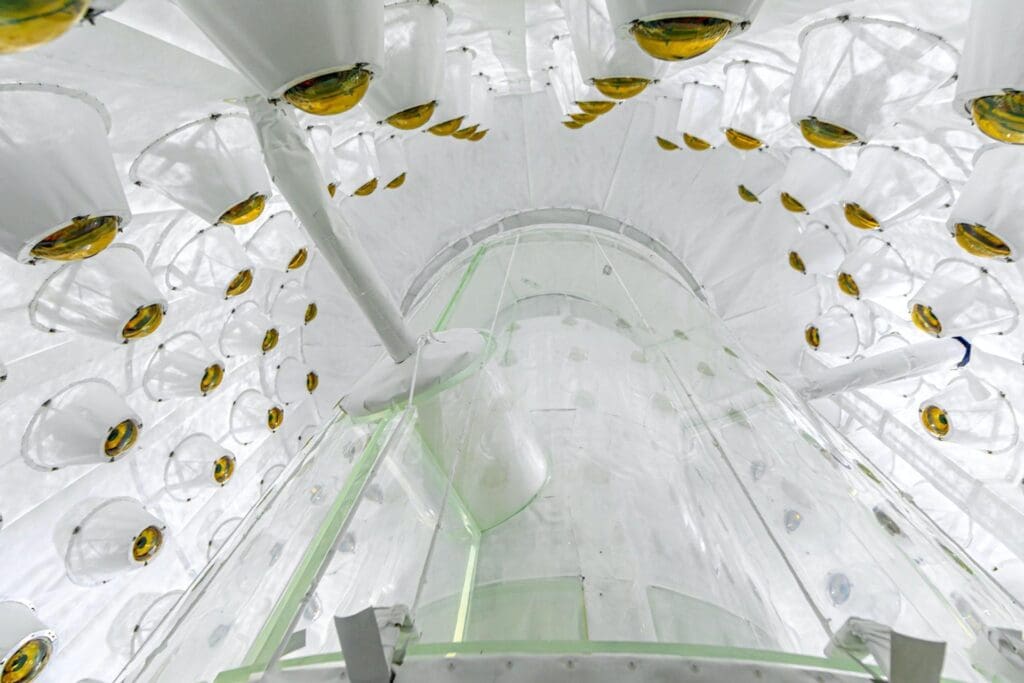Physicists like me don’t fully understand what makes up about 83% of the matter of the universe — something we call “dark matter.” But with a tank full of xenon buried nearly a mile under South Dakota, we might one day be able to measure what dark matter really is.
In the typical model, dark matter accounts for most of the gravitational attraction in the universe, providing the glue that allows structures like galaxies, including our own Milky Way, to form. As the solar system orbits around the center of the Milky Way, Earth moves through a dark matter halo, which makes up most of the matter in our galaxy.
I’m a physicist interested in understanding the nature of dark matter. One popular guess is that dark matter is a new type of particle, the Weakly Interacting Massive Particle, or WIMP. “WIMP” captures the particle’s essence quite nicely – it has mass, meaning it interacts gravitationally, but it otherwise interacts very weakly – or rarely – with normal matter. WIMPs in the Milky Way theoretically fly through us on Earth all the time, but because they interact weakly, they just don’t hit anything.
Over the past 30 years, scientists have developed an experimental program to try to detect the rare interactions between WIMPs and regular atoms. On Earth, however, we are constantly surrounded by low, nondangerous levels of radioactivity coming from trace elements – mainly uranium and thorium – in the environment, as well as cosmic rays from space. The goal in hunting for dark matter is to build as sensitive a detector as possible, so it can see the dark matter, and to put it in as quiet a place as possible, so the dark matter signal can be seen over the background radioactivity.
With results published in July 2023, the LUX-ZEPLIN, or LZ, collaboration has done just that, building the largest dark matter detector to date and operating it 4,850 feet (1,478 meters) underground in the Sanford Underground Research Facility in Lead, South Dakota.
At the center of LZ rests 10 metric tons (10,000 kilograms) of liquid xenon. When particles pass through the detector, they may collide with xenon atoms, leading to a flash of light and the release of electrons.
In LZ, two massive electrical grids apply an electric field across the volume of liquid, which pushes these released electrons to the liquid’s surface. When they breach the surface, they are pulled into the space above the liquid, which is filled with xenon gas, and accelerated by another electric field to create a second flash of light. Two large arrays of light sensors collect these two flashes of light, and together they allow researchers to reconstruct the position, energy and type of interaction that took place.
All materials on Earth, including those used in WIMP detector construction, emit some radiation that could potentially mask dark matter interactions. Scientists therefore build dark matter detectors using the most “radiopure” materials – that is, free of radioactive contaminants – they can find, both inside and outside the detector.
For example, by working with metal foundries, LZ was able to use the cleanest titanium on Earth to build the central cylinder – or cryostat – that holds the liquid xenon. Using this special titanium reduces the radioactivity in LZ, creating a clear space to see any dark matter interactions. Furthermore, liquid xenon is so dense that it actually acts as a radiation shield, and it is easy to purify the xenon of radioactive contaminants that might sneak in.
In LZ, the central xenon detector lives inside two other detectors, called the xenon skin and the outer detector. These supporting layers catch radioactivity on the way in or out of the central xenon chamber. Because dark matter interactions are so rare, a dark matter particle will only ever interact one time in the entire apparatus. Thus, if we observe an event with multiple interactions in the xenon or the outer detector, we can assume it’s not being caused by a WIMP.
All of these objects, including the central detector, the cryostat and the outer detector, live in a large water tank nearly a mile underground. The water tank shields the detectors from the cavern, and the underground environment shields the water tank from cosmic rays, or charged particles that are constantly hitting the Earth’s atmosphere.
In the result just published, using 60 days of data, LZ recorded about five events per day in the detector. That’s about a trillion fewer events than a typical particle detector on the surface would record in a day. By looking at the characteristics of these events, researchers can safely say that no interaction so far has been caused by dark matter. The result is, alas, not a discovery of new physics – but we can set limits on exactly how weakly dark matter must interact, as it remains unseen by LZ.
These limits help to tell physicists what dark matter is not – and LZ does that better than any experiment in the world. Meanwhile, there’s hope for what comes next in the search for dark matter. LZ is collecting more data now, and we expect to take more than 15 times more data over the next few years. A WIMP interaction may already be in that data set, just waiting to be revealed in the next round of analysis.
This article is republished from The Conversation, an independent nonprofit news site dedicated to sharing ideas from academic experts. The Conversation is trustworthy news from experts, from an independent nonprofit. Try our free newsletters.
Read more: Looking back toward cosmic dawn − astronomers confirm the faintest galaxy ever seen Most Americans support NASA – but don’t think it should prioritize sending people to space
Hugh Lippincott receives funding from the US Department of Energy Office of Science.
